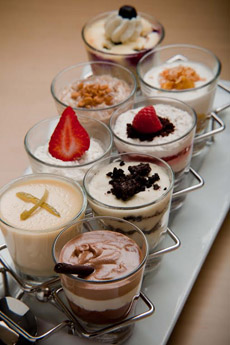Banana Pudding Recipe & The History Of Pudding
|
It’s getting hot and humid in our neck of the woods, and frozen desserts are a welcome way to cool down (like the banana pudding recipe below).
But what about the pudding family? A chilled dish of pudding is a cool summer dessert. This group of comfort foods includes banana, butterscotch, chocolate, coffee, salted caramel, vanilla…just name your favorite flavor and you can find a recipe for it. You can use instant pudding or make it from scratch, which, in our opinion, tastes even better. Here’s a from-scratch pudding recipe, which can be used to make any pudding flavor. Try this recipe for banana pudding from QVC’s David Venable. It starts with a base of instant vanilla pudding. We tried it both ways; and yes, we preferred our homemade vanilla pudding version. The difference in labor between from-scratch and instant is not great: Instant pudding mixes simply save you the time of measuring the sugar, cornstarch, vanilla, and salt. Some added stirring is required, but it’s no big deal. Says David, “This dessert is impossible to mess up. While it always turns out beautiful, it’s really just dumping a bunch of yummy ingredients into a bowl. Make it extra special by serving it in a footed glass bowl.” You can prepare the pudding up to two days ahead of time. |

Banana pudding with vanilla wafers and a twist: chopped nuts (photo © QVC). |
|
|
NANA’S “NANNER” PUDDING We substituted pistachios for the walnuts in Nana’s recipe. If you don’t want nuts, try mini chocolate chips or a salted caramel layer. We also made fresh whipped cream instead of using commercial whipped topping. Sorry, David: Our Nana would never approve of the shortcuts taken by your Nana. Ingredients |
||
 On the menu at East & West at the Yotel New York: A posse of puddings. |
Preparation
1. MIX the pudding and milk according to the package directions and then add the vanilla. 2. FOLD in the sour cream, 4 ounces of whipped topping, and 1/4 cup of chopped nuts. Refrigerate until the pudding is set or is needed (you can prepare the recipe in advance up to this point). 3. COMBINE the lemon juice with the banana slices in a medium-size bowl; set aside. 4. ALTERNATE layers of wafers, bananas, pudding, and optional salted caramel, in a large bowl or casserole dish, ending with the pudding. 5. DOLLOP the remaining whipped topping, followed by 6 or 7 crushed wafers and the remaining chopped walnuts. Refrigerate until set. If using fresh whipped cream, wait until serving to add the whipped cream, wafers and nuts. |
|
|
THE HISTORY OF PUDDING “Pudding” means different things in different cultures, and at different points in history. The creamy, rich dessert that Americans call pudding is more closely related to custard, which is made with eggs and dates to the Middle Ages. Today in the U.K., pudding typically refers to dessert but can be a savory recipe, such as Yorkshire pudding. The first puddings enjoyed by Greeks and Romans were similar to sausages, and for most of history, puddings were this type of boiled, meat-based dish. It was often stretched with other ingredients: The “pease porridge” in the old English nursery rhyme was a simple boiled pudding of pease meal, a roasted flour made from yellow field peas. The word “pudding” is believed to derive from the French boudin, meaning a small sausage. In these Medieval European puddings, encased meats similar to sausages were steamed or boiled to set the contents. Blood sausage and haggis are examples that are still “on the menu” in the U.K. These recipes helped to stretch a small amount of meat to feed a family. By the latter half of the 18th century, traditional English puddings no longer included meat; they were still boiled, but the finished product was cake-like (like plum pudding). Our creamy, modern puddings descend from this tradition of steaming sweet ingredients. According to Wikipedia, “The distinction between European custard and American pudding became muddled sometime in the 1840s.” Food was plentiful, so traditional boiled puddings were no longer necessary to feed a family. At the same time Alfred Bird, an English chemist, invented custard powder as an alternative to egg thickeners. Soon after, Americans began using the imported custard powder and other cornstarch derivatives as thickeners for custard-type desserts. Puddings no longer required the addition of fresh eggs to thicken, and this is where modern, eggless American puddings diverged from traditional egg custards. Instant pudding first appears in the U.S. in 1949. By 1952, Royal Pudding & Pie Fillings, still manufactured by Clabber Girl, advertised: “New homogenized Royal Instant Pudding makes your favorite desserts turn out better than ever before. New Royal Instant Pudding is completely different!” Our Nana still made pudding from scratch, but the rest is pudding history. |
||